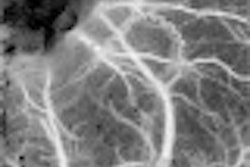SALT LAKE CITY - Ultrasound-guided thrombin injection for the treatment of iatrogenic pseudoaneurysms is safe and effective, but best reserved for cases with volumes smaller than 50 cm3, according to a presenter at the Society of Interventional Radiology conference.
"The overall incidence of pseudoaneurysm has been reported as being as high as 7.7% after percutaneous transluminal angioplasty and angiography," said Dr. Robert Arnett during a talk Saturday. "In the past, the first line of (treatment) was ultrasound-guided compression with only a 75% success rate. Surgical repair was the only other alternative." Arnett is a senior resident at Sacred Heart Medical Center in Spokane, WA.
Arnett and colleagues set out to determine the relationship between sheath size, thrombin dose, injection needle size, patient anticoagulation status, and the volume of the pseudoaneurysm as predisposing factors for treatment failure.
For the retrospective review conducted between November 1998 and March 2002, the charts of 77 patients with iatrogenic femoral artery pseudoaneurysms were reviewed. After catheterization, the patient underwent a percutaneous, ultrasound-guided injection of bovine thrombin powder (GenTrac, Middleton, WI) with either a 22- or a 25-gauge needle. The sheath size varied between 4-8 French, Arnett said.
The procedure was performed by 25 different radiologists at the community hospital, and the amount of thrombin injected (501-1,000 IU) was at the discretion of the treating physician, he explained. A follow-up sonogram was obtained in 51 of the 77 patients at 24 hours post-procedure. If the patient was asymptomatic, he or she was discharged with a follow-up ultrasound exam.
The overall success rate was 85%, according to the results. Ten of 77 treatments failed. Of these 10, nine required surgical correction while one patient underwent ultrasound-guided compression for thrombosis.
The pseudoaneurysm volume ranged from .05 cm3 to 228.4 cm3. Arnett and colleagues found a statistically significant relationship between volume and treatment failure: Four of the 5 pseudoaneurysms that were 50 cm3 or larger (based on a measurement of the entire lumen) did not respond to the treatment (p=.0001), Arnett said.
However, there was no statistically significant difference between treatment failure and sheath size, thrombin dose, or patient anticoagulation status. Among patients whose treatment was successful, no complications were reported, he said.
"(This) is a very straightforward procedure. It really only requires basic ultrasound-guidance skills. Twenty-five different radiologists performed (the procedure) and many of them were performing the procedure for the first time. Most radiologists should have the skills to perform ultrasound-guided thrombin injection treatment of pseudoaneurysms," Arnett concluded.
In response to questions from the audience, Arnett said the majority of pseudoaneurysm cases were referred to interventional radiology by cardiology, and that 24-hour ultrasound follow-up was done at the discretion of the referring physician.
By Shalmali PalAuntMinnie.com staff writer
April 1, 2003
Related Reading
US-guided core biopsy establishes malignancy in renal masses, August 22, 2002
Embolization technique shows promise for severe blunt renal injury, June 3, 2002
Copyright © 2003 AuntMinnie.com



















